The 2011 MacBook Air (11 & 13-inch): Thoroughly Reviewed
by Anand Lal Shimpi on July 28, 2011 3:25 AM EST- Posted in
- Apple
- Mac
- Intel
- Sandy Bridge
- MacBook Air
- Laptops
CPU Performance: A Huge Upgrade
I've got an expanded test suite here courtesy of the testing I did for our Lion review. As I mentioned in our Lion review, performance hasn't changed between Snow Leopard and Lion for the most part so the older data in these benchmarks is still quite valid.
Adobe Photoshop CS4
The old Air was not very good for those doing a lot of photo work. You could manage, and I definitely did, but it was painful. The story is completely different with the new MacBook Air however.
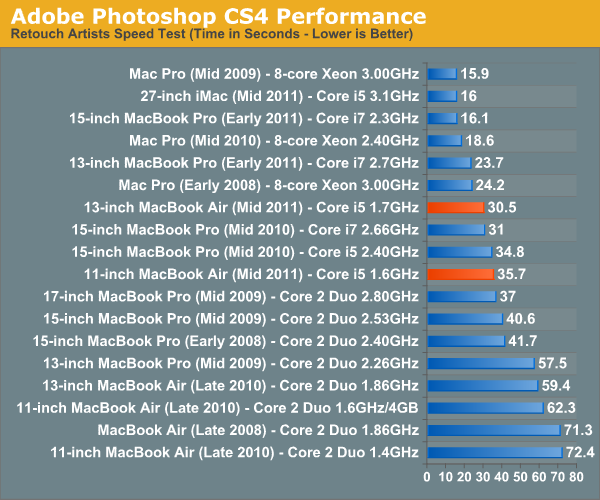
While the 2011 Macbook Pro is still considerably faster, completing our CS4 test in just over half the time as the 13-inch Air, these machines are competitive with last year's MBP. Remember the 2010 MacBook Pro only had two Arrandale cores and these Airs have lower clocked, but higher performing Sandy Bridge cores. Part of the performance advantage is the integrated SSD, whereas those older Macs didn't come with one by default. But most of the time these chips are running near their max turbo frequencies under load, which really helps narrow the performance gap between them and their 2010 professional counterparts.
If you have anything older than a 2010 MacBook Pro, these new Airs will actually be an upgrade for you.
Cinebench: Single & Multithreaded Performance
The old Air just wasn't that great of a performer. They were good enough if you didn't do much with your machine, but for those who lived on the bleeding edge they performed like a 3 year old MacBook Pro.
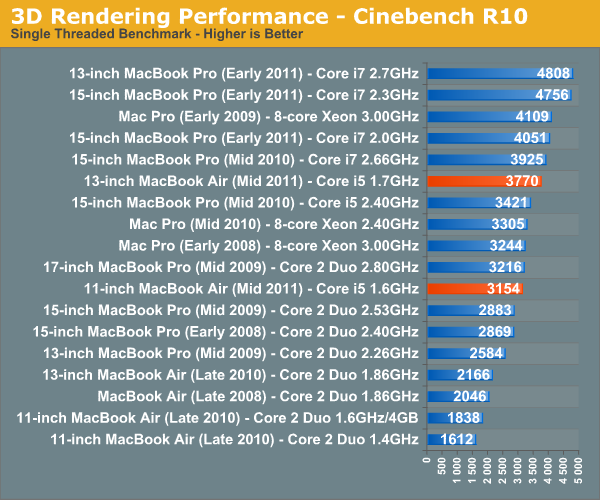
Single threaded performance on the new Air is much better than before thanks to turbo boost. The 11-inch MBA is 71% faster than the upgraded 11 from last year, that's more than noticeable in real world usage. The 13-inch MacBook Air enjoys a similar advantage over its predecessor.

Where things get even more ridiculous is in multithreaded performance:
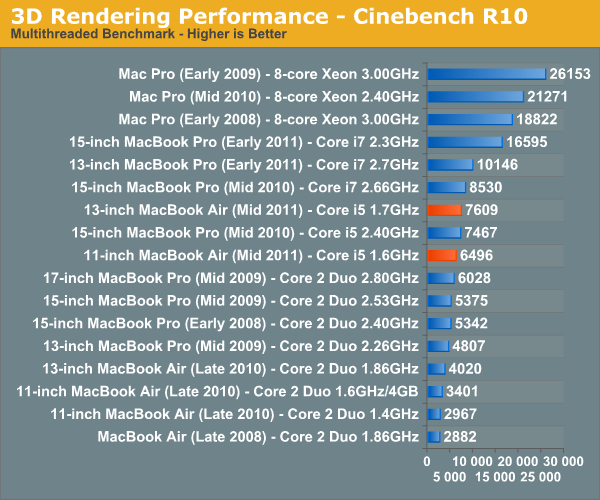
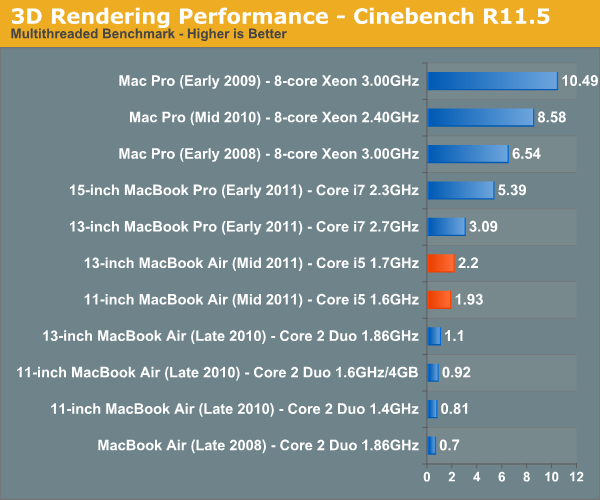
The single threaded performance of the new 11-inch MacBook Air is actually higher than the multithread performance of last year's model. Thanks to Hyper Threading and better performance per core you get around twice the performance of last year's models. Again the Air still isn't as good as the new quad-core MacBook Pros, but if you've got a machine from 2008 the new 13-inch MBA will actually be a performance upgrade (and a more portable machine).
Boot Performance
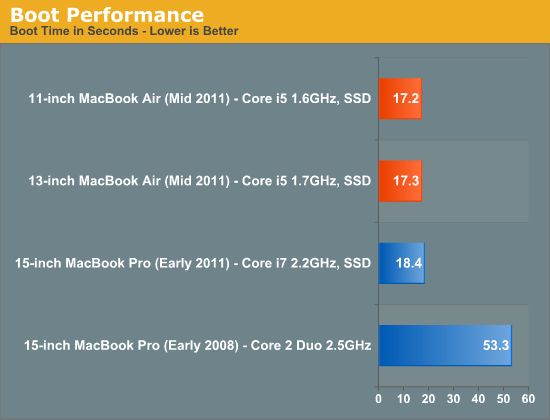
Boot time on these machines is great thanks to Apple's minimalist EFI and their SSDs. I will mention that the MacBook Air used to wake from sleep almost instantly however as of several OS revisions ago there seems to be a noticeable lag before I get a usable mouse cursor. I don't remember this being the case when the MacBook Air first came out and it's no different in Lion.
iMovie 11 Performance
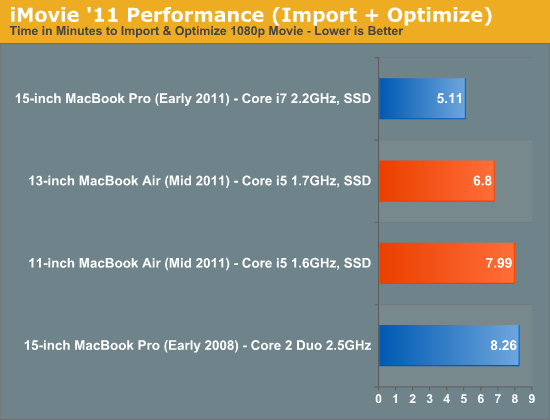
If you're going to be doing any video transcoding work you're going to want to upgrade the 11-inch MacBook Air's CPU. While it's much quicker than it used to be, the 1.6GHz Core i5 takes 17% longer to finish our iMovie import script than the 1.7GHz i5 in the 13-inch MacBook Air.
Exporting is a far bigger issue on these parts. Again the new systems are much faster than the old ones but if you're serious about video transcoding you should probably have a MacBook Pro.
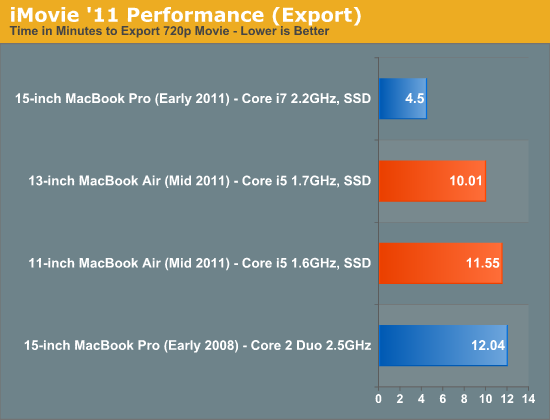
I'd also like to take this opportunity to say that it's absolutely ridiculous that Apple still doesn't support QuickSync in iMovie. We'd see far better performance from all Sandy Bridge equipped Macs if Apple would just take advantage of QuickSync. The silicon is there, it just needs to be used.
iPhoto 12MP RAW Import
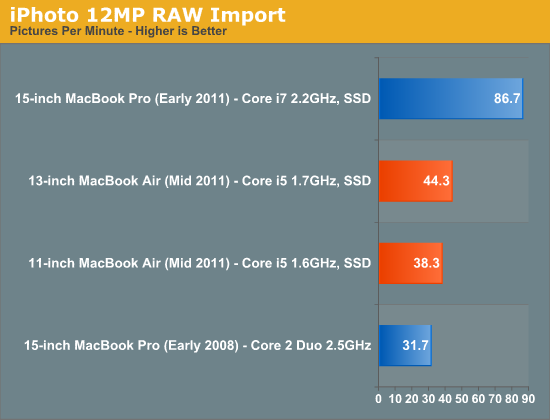
Here the new Airs do very well, but the 15-inch MacBook Pro is still around 2x the speed.
Adobe Lightroom 3
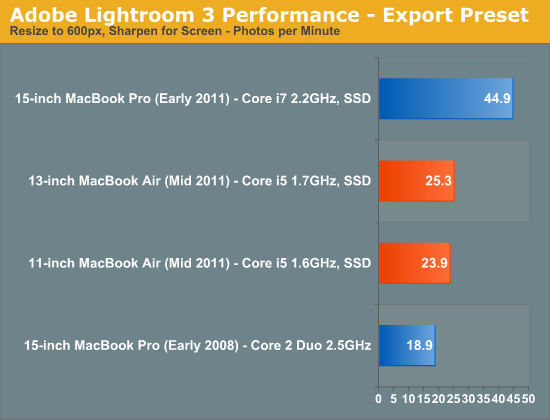
Final Cut Pro X
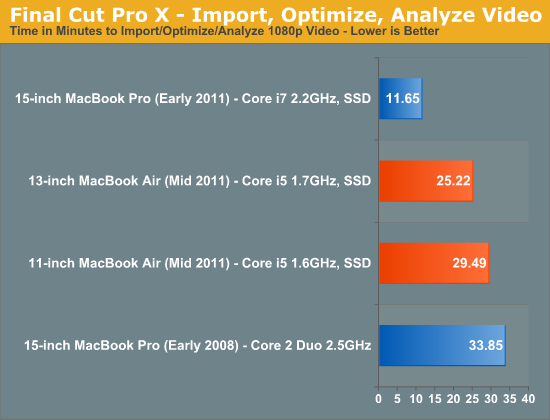
The trend continues. These new machines are faster than a 15-inch MacBook Pro from early 2008, but are no match for the new 2011 15-inch MacBook Pro. If you're going to do a lot of video encoding there's no replacement for more cores.










103 Comments
View All Comments
mschira - Friday, July 29, 2011 - link
well you are not thinking apple enough for this. saving 100$ is no reason accepting a mess on your table...besides who sais you need to toss the display when the gfx is outdated? what's keeping you from connecting the display via A dedicated GPU box once the internal GPU becomes to slow?
M.
darwinosx - Saturday, July 30, 2011 - link
In the display? So when the card is obsolete you get a new display? How about outside the laptop and the display but in between both.AJ Driver - Thursday, July 28, 2011 - link
Thanks Anand :)The irony for me reading your review and others around the internet is the comparison in performance between these MBAs and other models (both new and old).
My personal laptop is a 5, going on 6, year old Macbook and for what I use it for it's more than good enough. It's pretty incredible the way technology is advancing, and if the current pc stays the course I wait as long as I can before taking the leap.
It's hard to deny the urge to upgrade though!
Marand - Thursday, July 28, 2011 - link
Well I thought I was finally clear that I was going to buy a MacBook Pro 13 but now I am not so sure.I mainly use my laptop for software development. My previous one was MacBook pro 2007 model which served me well.
My issue with the pro line is that because of their weight, it just ends up becoming a desktop that I don't take with with me and always plugged into a large screen.
But having the ability to put 8 gigs of ram and update the hard drive on the new MBPro is a nice option to have.
I really hoped that apple was going to release MBAs with 8 gigs of ram at least and even if you can't upgrade the hard drive (although I heard you can with prev gen from OWC) you could always plug in bigger drives through thunderbolt if and when drives comes out.
The big selling factor for the MBA for me was the weight. I figured it would be super easy to take with me where and when I want without treating it like a desktop.
I know the MBAs are not targeted to developers. Ut I know plenty who were hoping for "more" from MBA
So now I have a tough choice because the MBpro 15 with quad core and the hi res anti glare screen is packed with power even if it's heavier and likely has more long term capability.
Oh well, can't have it all I guess...
A5 - Thursday, July 28, 2011 - link
If the 15" MBP is too heavy for you, you may want to get a more supportive bag or something. I would've killed for a 5.6lb 15" laptop 8 years ago :PUritziel - Thursday, July 28, 2011 - link
Remember, you're not supposed to carry it around attached to your ear lobe :)I carried a 17-inch DTR laptop that weighed about 10 lbs. around campus for a year, so 5.6 lbs. sounds light to me too. I consider battery life as the main metric of portability after weight hits that 5 lbs. mark.
crimson117 - Thursday, July 28, 2011 - link
>The only exception is if you're just going to spend your time doing very basic tasks on the machine and plan on upgrading again in a year or two. If that's the case save your money and enjoy a 4GB version with Ivy Bridge next year.People who can afford a new MacBook Air every time a new one comes out aren't going to be worried about saving their money on a ram upgrade :)
steven75 - Thursday, July 28, 2011 - link
Apple hardware has incredible resale value, so it's actually easier to do than you think.Uritziel - Thursday, July 28, 2011 - link
Don't forget that if you buy a laptop for $2000 today and sell it at that great Apple resale value of say $1000 (numbers are random) in a few years when you're ready to upgrade, the laptop did NOT cost $1000 in the end.Adding on the effort required to resell it, that rationale makes a lot less sense than some people claim.
Rasterman - Wednesday, August 3, 2011 - link
I'm looking at upgrading right now so I looked up the resale value of mine. I bought a new MB for $1150 in 2008, used prices are $500-$800 right now, I expect to sell mine north of $700 since it is in brand new condition as I only used it as a dev machine when porting and it has seen very little use. So my expected resale value is 61% after 3 years which is pretty damn good IMO.